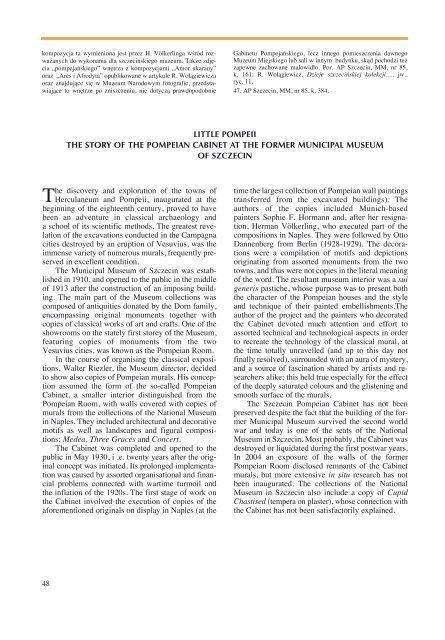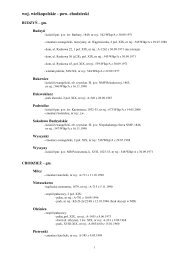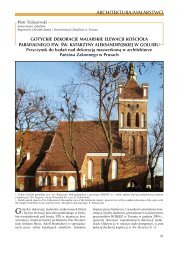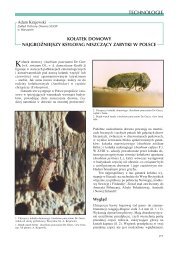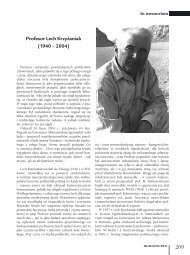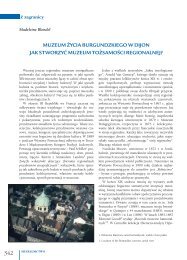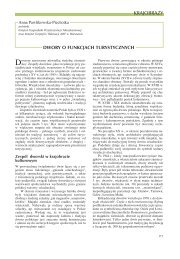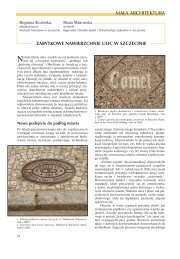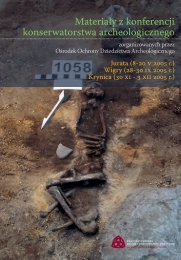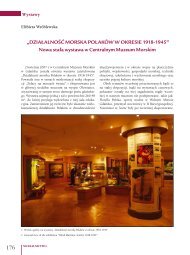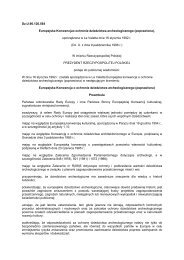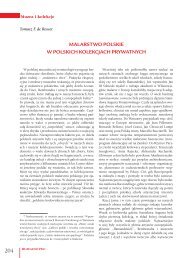Małe Pompeje. Gabinet Pompejański w dawnym Muzeum Miejskim ...
Małe Pompeje. Gabinet Pompejański w dawnym Muzeum Miejskim ...
Małe Pompeje. Gabinet Pompejański w dawnym Muzeum Miejskim ...
You also want an ePaper? Increase the reach of your titles
YUMPU automatically turns print PDFs into web optimized ePapers that Google loves.
kompozycja ta wymieniona jest przez H. Völkerlinga wÊród rozwa˝anych<br />
do wykonania dla szczeciƒskiego muzeum. Tak˝e zdj´cia<br />
„pompejaƒskiego” wn´trza z kompozycjami „Amor ukarany”<br />
oraz „Ares i Afrodyta” opublikowane w artykule R. Wo∏àgiewicza<br />
oraz znajdujàce si´ w <strong>Muzeum</strong> Narodowym fotografie, przedstawiajàce<br />
to wn´trze po zniszczeniu, nie dotyczà prawdopodobnie<br />
The discovery and exploration of the towns of<br />
Herculaneum and Pompeii, inaugurated at the<br />
beginning of the eighteenth century, proved to have<br />
been an adventure in classical archaeology and<br />
a school of its scientific methods. The greatest revelation<br />
of the excavations conducted in the Campagna<br />
cities destroyed by an eruption of Vesuvius, was the<br />
immense variety of numerous murals, frequently preserved<br />
in excellent condition.<br />
The Municipal Museum of Szczecin was established<br />
in 1910, and opened to the public in the middle<br />
of 1913 after the construction of an imposing building.<br />
The main part of the Museum collections was<br />
composed of antiquities donated by the Dorn family,<br />
encompassing original monuments together with<br />
copies of classical works of art and crafts. One of the<br />
showrooms on the stately first storey of the Museum,<br />
featuring copies of monuments from the two<br />
Vesuvius cities, was known as the Pompeian Room.<br />
In the course of organising the classical expositions,<br />
Walter Riezler, the Museum director, decided<br />
to show also copies of Pompeian murals. His conception<br />
assumed the form of the so-called Pompeian<br />
Cabinet, a smaller interior distinguished from the<br />
Pompeian Room, with walls covered with copies of<br />
murals from the collections of the National Museum<br />
in Naples. They included architectural and decorative<br />
motifs as well as landscapes and figural compositions:<br />
Medea, Three Graces and Concert.<br />
The Cabinet was completed and opened to the<br />
public in May 1930, i .e. twenty years after the original<br />
concept was initiated. Its prolonged implementation<br />
was caused by assorted organisational and financial<br />
problems connected with wartime turmoil and<br />
the inflation of the 1920s. The first stage of work on<br />
the Cabinet involved the execution of copies of the<br />
aforementioned originals on display in Naples (at the<br />
48<br />
<strong>Gabinet</strong>u Pompejaƒskiego, lecz innego pomieszczenia dawnego<br />
<strong>Muzeum</strong> Miejskiego lub sali w innym budynku, skàd pochodzi te˝<br />
zapewne zachowane malowid∏o. Por. AP Szczecin, MM, nr 85,<br />
k. 161; R. Wo∏àgiewicz, Dzieje szczeciƒskiej kolekcji…, jw.,<br />
ryc. 11.<br />
47. AP Szczecin, MM, nr 85, k. 384.<br />
LITTLE POMPEII<br />
THE STORY OF THE POMPEIAN CABINET AT THE FORMER MUNICIPAL MUSEUM<br />
OF SZCZECIN<br />
time the largest collection of Pompeian wall paintings<br />
transferred from the excavated buildings). The<br />
authors of the copies included Munich-based<br />
painters Sophie F. Hormann and, after her resignation,<br />
Herman Völkerling, who executed part of the<br />
compositions in Naples. They were followed by Otto<br />
Dannenberg from Berlin (1928-1929). The decorations<br />
were a compilation of motifs and depictions<br />
originating from assorted monuments from the two<br />
towns, and thus were not copies in the literal meaning<br />
of the word. The resultant museum interior was a sui<br />
generis pastiche, whose purpose was to present both<br />
the character of the Pompeian houses and the style<br />
and technique of their painted embellishments.The<br />
author of the project and the painters who decorated<br />
the Cabinet devoted much attention and effort to<br />
assorted technical and technological aspects in order<br />
to recreate the technology of the classical mural, at<br />
the time totally unravelled (and up to this day not<br />
finally resolved), surrounded with an aura of mystery,<br />
and a source of fascination shared by artists and researchers<br />
alike; this held true especially for the effect<br />
of the deeply saturated colours and the glistening and<br />
smooth surface of the murals.<br />
The Szczecin Pompeian Cabinet has not been<br />
preserved despite the fact that the building of the former<br />
Municipal Museum survived the second world<br />
war and today is one of the seats of the National<br />
Museum in Szczecin. Most probably, the Cabinet was<br />
destroyed or liquidated during the first postwar years.<br />
In 2004 an exposure of the walls of the former<br />
Pompeian Room disclosed remnants of the Cabinet<br />
murals, but more extensive in situ research has not<br />
been inaugurated. The collections of the National<br />
Museum in Szczecin also include a copy of Cupid<br />
Chastised (tempera on plaster), whose connection with<br />
the Cabinet has not been satisfactorily explained.


